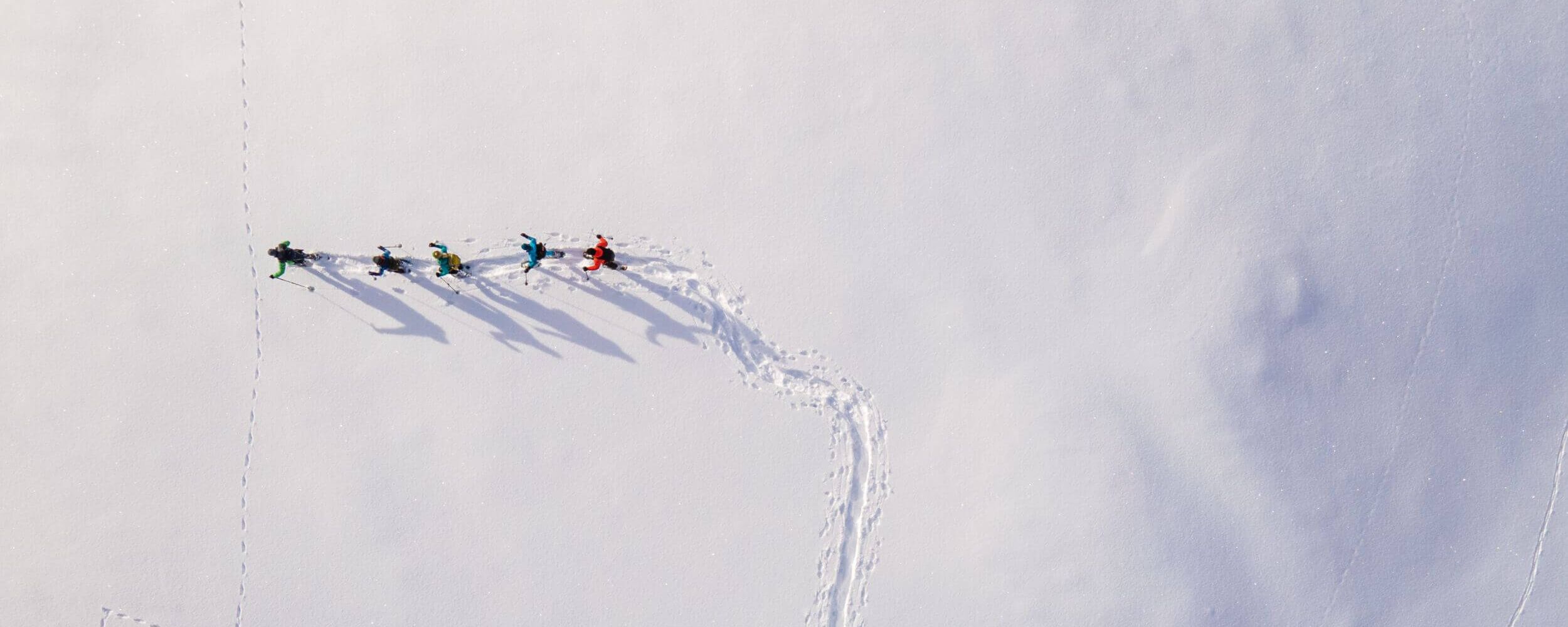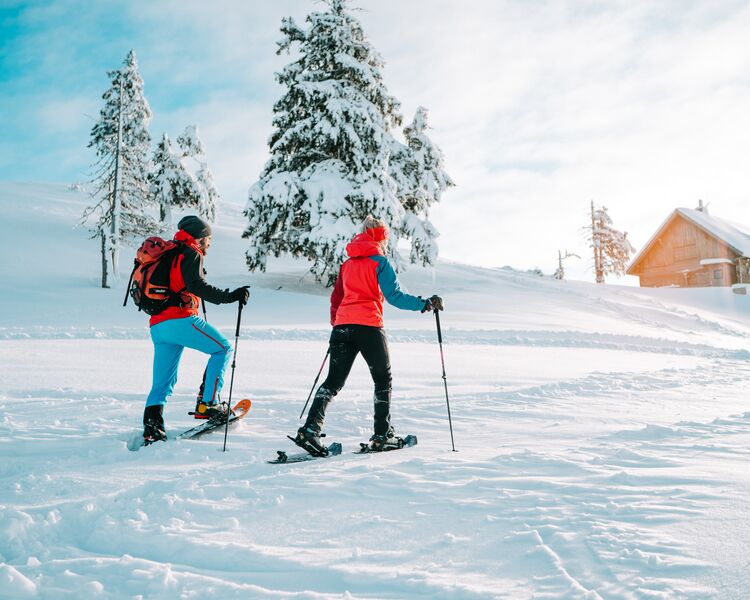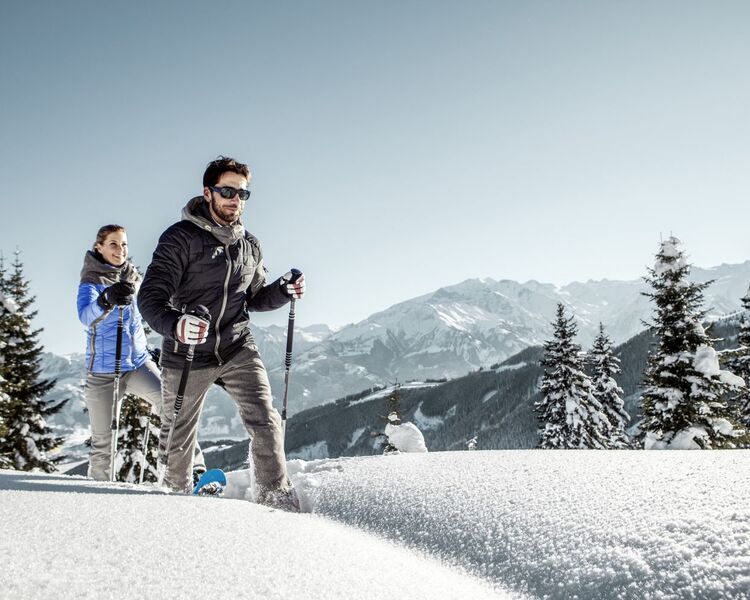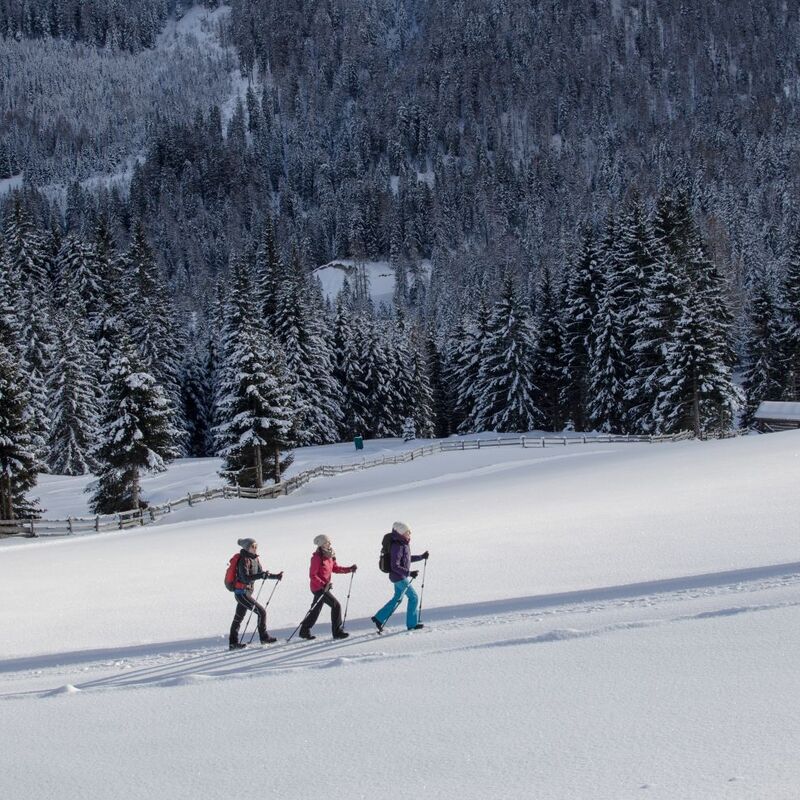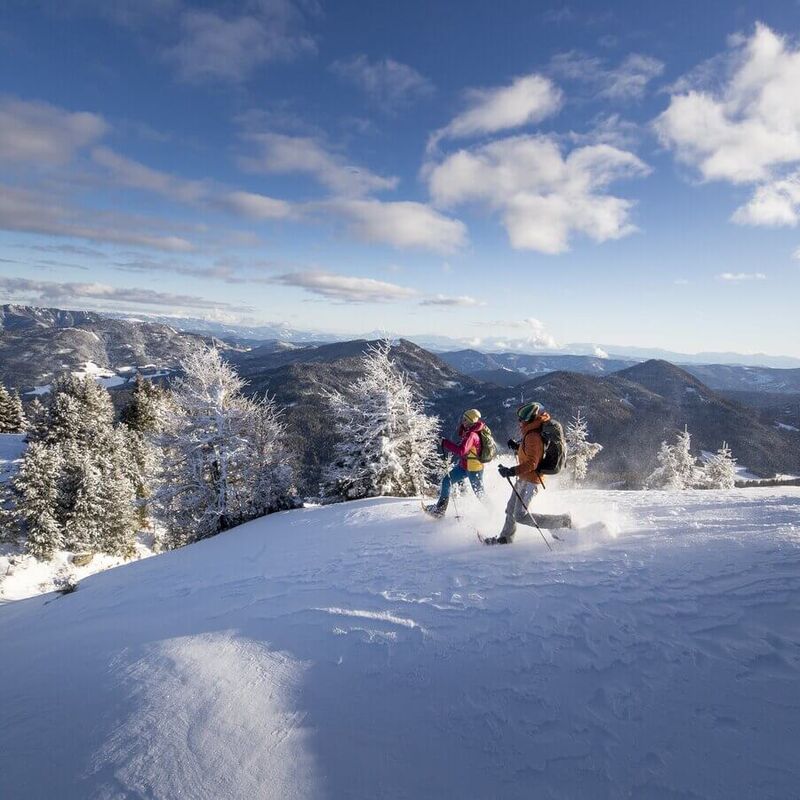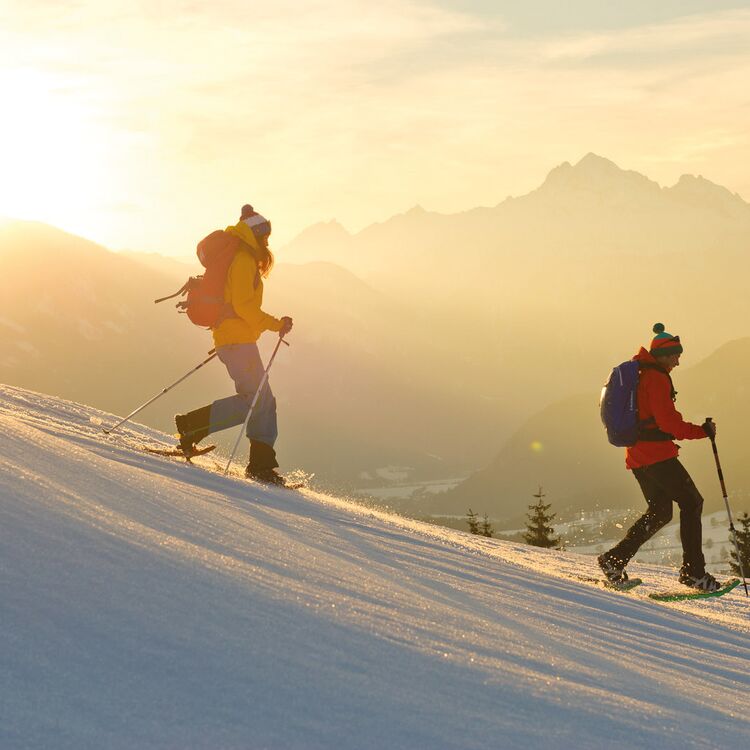At a glance
From the snowshoe tour straight onto the slopes? Then take a look at our overview of Nassfeld, Turracher Höhe and the Gerlitzen.
Snowshoeing in Austria
a Gentle Winter Experience
Experience the silent and mesmerizing side of winter whilst snowshoeing in Austria. Far from the hustle of children's play areas and ski lifts, you'll tread through the snow, savoring the tranquility and beauty of the solitary winter landscape. On your journey, breathe in the crisp winter air, spot animal tracks in the snow, and with each step, leave your daily routine behind. Don’t forget your camera – amidst so much pristine nature, countless photo opportunities await!
Austria: A Diverse Snowshoeing Paradise
In the winter, Austria reveals itself in its full glory and, in some regions, it becomes a true snowshoeing paradise. With majestic mountains and valley basins, forests blanketed deep in snow, expansive alpine pastures, and picturesque villages, it offers a wealth of options for snowshoe hikes. The snow transforms Austria’s nature into a winter wonderland – sparkling ice crystals, twirling snowflakes, and the softest powder snow as far as the eye can see.
Incidentally: Snowshoeing is one of the most eco-friendly winter sports there is. It doesn't require groomed pistes or snowcats, modern lifts or snow cannons. Bearing that in mind, please respect your natural surroundings. Obey local regulations intended to preserve nature and wildlife. Don't leave trash behind, and don't enter restricted areas that have been closed off to the general public.
Why Snowshoeing is Captivating: The Benefits
Snowshoeing is essentially a celebration for the body, mind, and soul! The uniform, moderate, and joint-friendly movement in the fresh air strengthens our immune system, our stamina, and coordination. It boosts the cardiovascular system and fat burning; and our muscles get an excellent workout, of course. Snowshoeing primarily exercises the legs and buttocks, but it also keeps the back and upper arm muscles busy, too! The tranquility and steady motion help to clear the mind and slow things down in general. Just breathe deeply. You’ll soon become aware that your everyday cares shrink into insignificance, one stride at a time.
Compared to sports like skiing, snowshoeing is, by and large, a very safe winter sport. Naturally, this assumes good tour planning, which includes checking and correctly assessing the current weather and avalanche conditions.
Healthy Winter Sport for Everyone
Snowshoeing is considered a gentle sport that can be enjoyed at any age. The joy of tramping through deep snow is as much fun for children as it is for their grandparents. A good basic level of fitness is all you need, at which point nothing more stands in the way of your first snowshoe tour in Austria. The sport is easy to learn and often leads to quick success. For tips and tricks for beginner snowshoers, be sure to check out our ALPS Magazine article "Snowshoeing for Beginners – Tips & Tricks".
Another considerable plus of snowshoeing: The gear is significantly more affordable than, for instance, a full ski setup including skis, ski boots, poles, etc.
6 Popular Regions for Snowshoeing in Austria
Brixental, Kitzbühel Alps: Truly laid-back snowshoe hikes can be enjoyed on the gentle “grass mountains” of Brixental in the Kitzbühel Alps. Your always-snowy tour in Wildschönau starts at the summit station of the Markbachjochbahn lifts (Niederau, about a 15-minute drive from the Brixental Suites and Chalet 149 Westendorf. The route leads through sparse forests and gentle alpine terrain to the Kasalm / Brixentaler Holzalm. It then continues to the Halsgatterl chapel, which you'll reach after about 1 more kilometer and not even 50 meters in elevation gain. From there, head to the Lanerköpfel and back through the forest to the Markbachjochbahn. Total length: 6.5 km; Duration: approx. 2.5 hours
Wipptal: Located about 30 km from Innsbruck, Wipptal was named a GEO Top 10 travel destination in 2017, captivating those seeking peace and quiet as well as active holidaymakers and families. Snowshoes can be rented at the tourist office (even in children's sizes!), and guided snowshoe hikes are offered from December to March.
Villach, Gerlitzen & Dobratsch: A brilliant combination of mountain & lake awaits you in the Villach region: The Gerlitzen Alpe is situated above the Ossiacher See. On the Gerlitzen, you have a total of 12 kilometers of winter hiking trails to choose from. Guided snowshoe tours and full moon hikes are offered on Villach's local mountain, the Dobratsch, which is clearly visible from the Gerlitzen.
Raurisertal, Ferienregion Nationalpark Hohe Tauern: IAt the valley head of Raurisertal, known as Kolm Saigurn, you will find a marked snowshoe trail from Alpengasthof Bodenhaus (1,280 m) to the Ammererhof and Naturfreundehaus (1,600 m) at the foot of the Hoher Sonnblick (approx. 4 km, 320 vm and 3 h walking time – one way!). The return journey is faster: you can borrow a sled from either of the two inns located at the valley head and toboggan back down the toll road. Yet another highlight is a tour through the Rauris Virgin Forest. The tourist office offers guided snowshoe hikes with a national park ranger from the end of December to the end of March.
Murau – Murtal: In the region around the “World Championship Mountain” of the Kreischberg and in Zirbitzkogel-Grebenzen Nature Park, you can unwind splendidly on various snowshoe hikes, ranging from easy outings for beginners to truly challenging snowshoe tours, with or without a guide. Intriguing: On the Turracher Höhe, a trained biosphere ranger accompanies you on a snowshoe hike through Europe's largest contiguous expanse of pine forests.
Gailtal, Kärnten: At the entrance to the Lesach Valley, just 14 km from the Italian border and the Plöcken Pass, lies Kötschach-Mauthen. Mauthen has been an excellent mountaineering village since 2011. The region is particularly popular with guests in search of peace and quiet, and with foodies: The Gail Valley is the first Slow Food Travel destination and self-proclaimed "Most Delicious Corner of Carinthia". A popular snowshoe hike starts at the ALPS RESORT "Chalets & Glamping Nassfeld", adjacent to the Aquarena in Kötschach-Mauthen: the so-called “Vorhegg Loop”. You will start your expedition right by your glamping accommodations, head towards Vorhegg, cross meadows and pass mountain farms, until you finally reach the Ödenhütte (approx. 380 vm).
Prepare Well for Your Snowshoe Hikes
For optimal preparation, please bear in mind the following:
- Self-Assessment: Be honest with yourself and choose a snowshoe hike that matches your actual fitness level and ability.
- Planning: Visiting the local tourist information office on-location can be very helpful. You can also find details about potential tours in hiking guidebooks, on websites, apps, and local hiking forums.
- Difficulty Level: Pay close attention to the elevation gain, length, and terrain of the snowshoe hike.
- Maps and GPS: Having a map and a GPS device, or smartphone apps with GPS function, can be useful for navigating the area.
- Weather and snow conditions: Stay informed about current and forecasted weather as well as avalanche risks in the region. Pack appropriate clothing and gear. In extreme conditions like heavy snowfall or avalanche warnings, it really is best to cancel or at least postpone your hike.
- Emergency gear: A first-aid kit, flashlight, multitool, and a charged mobile phone are essential. For backcountry treks, don't forget an avalanche probe, shovel, and a transponder!
- Companion: If at all possible, hike with others. Let friends or family know your route and expected return time.
The Right Gear for Snowshoeing in Austria
Setting out on a snowshoe hike in Austria requires proper equipment and thorough preparation!
Snowshoes:Their large surface area prevents you from sinking into deep snow. Seek advice on the size and quality of snowshoes suited to your height and weight from expert staff at sporting goods stores. Tip: Most winter sports resorts in Austria offer snowshoe rentals. Ask at your reception for contact information.
Sturdy Footwear: Warm, waterproof, ankle-high hiking boots with firm soles are recommended to withstand snow and cold. For freezing temperatures, insulated shoes and thick socks are your best bet.
Telescopic Poles with Snow Baskets : These help maintain balance and give your upper arms a workout, too 😉
Appropriate Clothing: Dress in layers to protect against the cold, including wind and waterproof garments. We recommend the “onion layering” principle for best managing temperature fluctuations. Essential items also include good gloves, a hat, a neck gaiter, and sunglasses.
Backpack: Pack your cell phone, spare clothes, a warm drink and a snack, a map of the tour, a headlamp, a first aid kit, and emergency equipment. Don't forget sunglasses as well as sunscreen and/or a cream for added protection against the cold.
FAQs: Frequently asked questions about snowshoeing in Austria
Yes, indeed. In Austria, there are numerous providers that offer guided snowshoe hikes. These guided tours are perfect for beginners and afford an excellent opportunity to discover the region's prime routes alongside an experienced guide. For the best experience, we recommend visiting the tourism website of the holiday region where you've booked to find information on guided snowshoe hikes available during your stay.
The best season for snowshoe hiking in Austria typically spans from December to March, when the winter landscapes are at their most magnificent. However, the exact timing will vary depending on the region and weather conditions. We advise getting the most up-to-date information in advance.
At www.lawine.at, you can find the most recent reports about avalanche conditions in each Austrian province, allowing you to carefully plan a safe snowshoeing expedition here in Austria.
Copyright © Ferienregion Nationalpark Hohe Tauern, TVB Rauris (Fotograf Florian Bachmeier), Kitzbüheler Alpen Marketing (Fotograf Kurt Tropper), Kärnten Werbung (Fotograf Franz Gerdl), Martin Hofmann, Schnittenhohenbahn, TVB Wipptal, Tom Lamm, Rossmann

Lisa Gruber
Content Marketing bei ALPS RESORTS
Gen-Z with a penchant for writing and being outdoors. Lisa enjoys discovering hikes and ski resorts for us and offers tips for the perfect vacation.
Would you like to learn more about ALPS RESORTS? Feel free to use our contact form or submit a non-binding inquiry.
Subscribe to the newsletter now and benefit!
Exclusive offers and discounts as well as exciting news from ALPS RESORTS.

